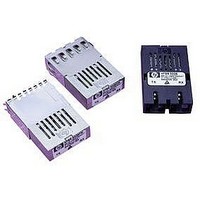HFBR-5205 Avago Technologies US Inc., HFBR-5205 Datasheet - Page 8

HFBR-5205
Manufacturer Part Number
HFBR-5205
Description
Fiber Optics, Transceiver Module
Manufacturer
Avago Technologies US Inc.
Datasheet
1.HFBR-5205.pdf
(21 pages)
Available stocks
Company
Part Number
Manufacturer
Quantity
Price
Company:
Part Number:
HFBR-5205
Manufacturer:
AVAG
Quantity:
5 069
Part Number:
HFBR-5205
Manufacturer:
AGILENT
Quantity:
20 000
The transceivers may be used for
other applications at signaling
rates different than 155 Mbps
with some variation in the link
optical power budget. Figure 5
gives an indication of the typical
performance of these products at
different rates.
These transceivers can also be
used for applications which
require different Bit Error Rate
(BER) performance. Figure 6
illustrates the typical trade-off
between link BER and the
receivers input optical power
level.
Transceiver Jitter Performance
The Avago 1300 nm transceivers
are designed to operate per the
system jitter allocations stated in
Table B1 of Annex B of the draft
ANSI T1E1.2 Revision 3 standard.
Figure 5. Transceiver relative optical power budget at
constant BER vs. signaling rate.
8
2.5
2.0
1.5
1.0
0.5
0.5
0
CONDITIONS:
1. PRBS 2
2. DATA SAMPLED AT CENTER OF DATA SYMBOL.
3. BER = 10
4. T
5. V
6. INPUT OPTICAL RISE/FALL TIMES = 1.0/2.1 ns.
0
A
CC
25
= 25° C
= 5 V
7
50
-1
-6
dc
SIGNAL RATE (MBd)
75
100
125
150
175
200
The Avago 1300 nm transmitters
will tolerate the worst case input
electrical jitter allowed in Annex
B without violating the worst case
output optical jitter requirements.
The Avago 1300 nm receivers will
tolerate the worst case input
optical jitter allowed in Annex B
without violating the worst case
output electrical jitter allowed.
The jitter specifications stated in
the following 1300 nm transceiver
specification tables are derived
from the values in Table B1 of
Annex B. They represent the
worst case jitter contribution that
the transceivers are allowed to
make to the overall system jitter
without violating the Annex B
allocation example. In practice,
Figure 6. Bit error rate vs. relative receiver input optical
power.
1 x 10
1 x 10
1 x 10
1 x 10
1 x 10
1 x 10
1 x 10
1 x 10
1 x 10
1 x 10
1 x 10
-10
-11
-12
-2
-3
-4
-5
-6
-7
-8
-9
-6
CONDITIONS:
1. 155 MBd
2. PRBS 2
3. CENTER OF SYMBOL SAMPLING.
4. T
5. V
6. INPUT OPTICAL RISE/FALL TIMES = 1.0/2.1 ns.
RELATIVE INPUT OPTICAL POWER – dB
A
CC
= 25° C
= 5 V
-4
7
-1
dc
AFBR-5205Z
-2
CENTER OF SYMBOL
the typical contribution of the
Avago transceivers is well below
these maximum allowed amounts.
Recommended Handling
Precautions
Avago recommends that normal
static precautions be taken in the
handling and assembly of these
transceivers to prevent damage
which may be induced by
electrostatic discharge (ESD). The
AFBR-5205Z series of transceivers
meet MIL-STD-883C Method
3015.4 Class 2 products.
Care should be used to avoid
shorting the receiver data or
signal detect outputs directly to
ground without proper current
limiting impedance.
0
2
4






















